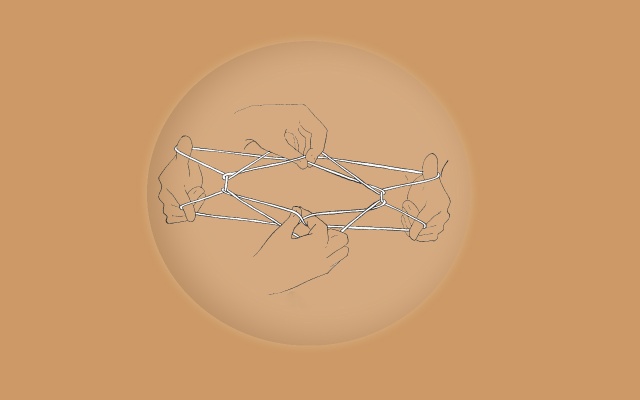The awareness that we Earthlings are part of the material, planetary community seems to be an obvious and necessary precondition for us to take effective action against the continuous devastation of the Earth. Today, it is clear that all human Earthlings – through their communal participation in the processes of the flow of energy and matter – become the Earth; nevertheless, the anthropocentric attitudes that have been perpetuated for centuries, which exclude people from such a community, are still refusing to finally become a thing of the past.
In these circumstances, it is worth reflecting in depth on the entangled planetary processes of becoming-Earthlings and becoming-the-Earth. The first of these comprises living matter in the form of various earthly beings – Earthlings. The second, however, has a broader span – encompassing both the Earth dwellers and inorganic matter such as stone, sand, silt and dust, but also such anthropogenic substances as plastic. These processes, all planetary in character, reveal that humans emerge alongside other biological species and mineral species that are subject to the impact of the environment. And thus, “the unity of life is not an end, a final harmony or cohesion, but the beginning, the impetus all of life shares with the chemical order from which it differentiates itself, and which it carries within it as its inherited resource.”[1]. Moreover, the evolution of life and the evolution of the planet, as natural history, fuse into one with social history. This sets out not only the biological context – treated in the categories of life (bios, zoe) and death (thanatos), but also the geological (geos), with the inclusion of the mineral (nonlife) component.
The planetary scale thus opens up a perspective in which deep (geological) time is linked to species-evolutionary time and individual time that includes both humans and nonhumans, as the geographer Kathryn Yusoff points out. Writing about the geological turn that we now observe in the humanities and artistic activity, she maintains that today we “take seriously not just our biological (or biopolitical) life, but also our geological (or geopolitical) life and its forms of differentiation,”[2] a view shared by the anthropologist Elizabeth A. Rejecting the dominant discourse of biopolitics and biopower, she proposes concepts such as “gerontology” and “geontopower,” intended to introduce into Western ontology also the nonlife (geos). The author does not suggest, however, that geontopower should be something new. Instead, she argues that making the distinction between life and nonlife – as active and passive – lies at the basis of various forms of power, including biopower, and this differentiation is currently being undermined in different ways. Aiming to expand Western ontology, dominated by Life and the desire for Life,[3] in her book Geontologies: A Requiem to Late Liberalism, Povinelli seeks to go beyond the dominant discourse of biopolitics and necropolitics. According to Povinell, the difference between Life and Nonlife is the basis of the Western ontologies, which are in fact disguised biontologies. And yet, "it is a difference that makes no difference," as evidenced, for example, by the virus capable of ignoring the life/nonlife dichotomy. Adopting to the prevailing conditions, the virus replicates itself or bides its time; thereby, “it confuses and levels the difference between Life and Nonlife while carefully taking advantage of the minute aspects of their differentiation.”[4]
Earthlings of All Species, Unite!
Earthlings encompass all the known forms of organic life. With their shared heritage, they are not only related but also linked by a corporeal materiality, which all the participants in metabolic processes have in common. Views that assumed the hierarchical structure of beings – derived from Plato and Aristotle, and subsequently maintained and developed in the Middle Ages and reflected in the concept of the Great Chain of Being that dominated until Charles Darwin – marginalized mineral species at the very bottom of the hierarchy of beings. In turn, the theory of evolution emerged in the face of the division that arose between the subject of research in biology and geology. This manner of organization of knowledge was reflected in museums of natural history, in which minerals were usually displayed in separate galleries as fundamentally passive matter that did not undergo any transformations. Today, the situation is changing; many museums of natural history are proposing new ways of exhibiting minerals. In our time, the need to broaden the perspective to include minerals has become self-evident, especially if we consider the entire planet as an ecosystem, with its biochemical cycles, that is the circulation of the elements and chemical compounds, e.g. carbon, oxygen, nitrogen, phosphorus, or water. These cycles often combine species long extinct and those living today and also to a certain extent these that are yet to come. All the processes of the flow of matter and energy in different rocks set out the communal perspective, since the Earthlings that live on planet Earth, as well as the actual earthly matter or mineral species, have the character of a metabolic community.
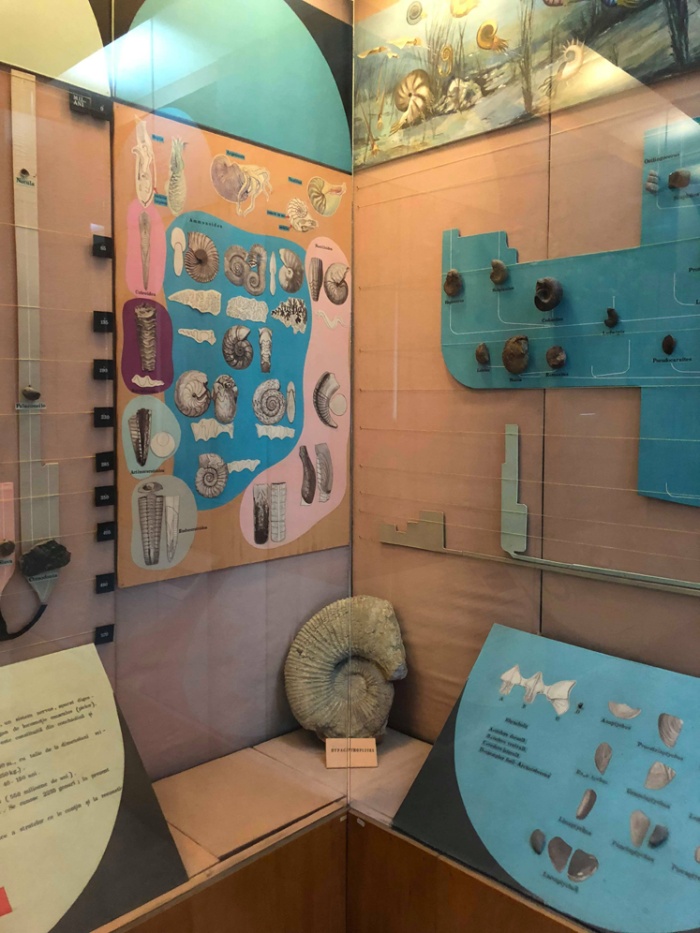
Narodowe Muzeum Geologiczne w Bukareszcie. Zdjęcie: Bianka Basan. Dzięki uprzejmości artystki.
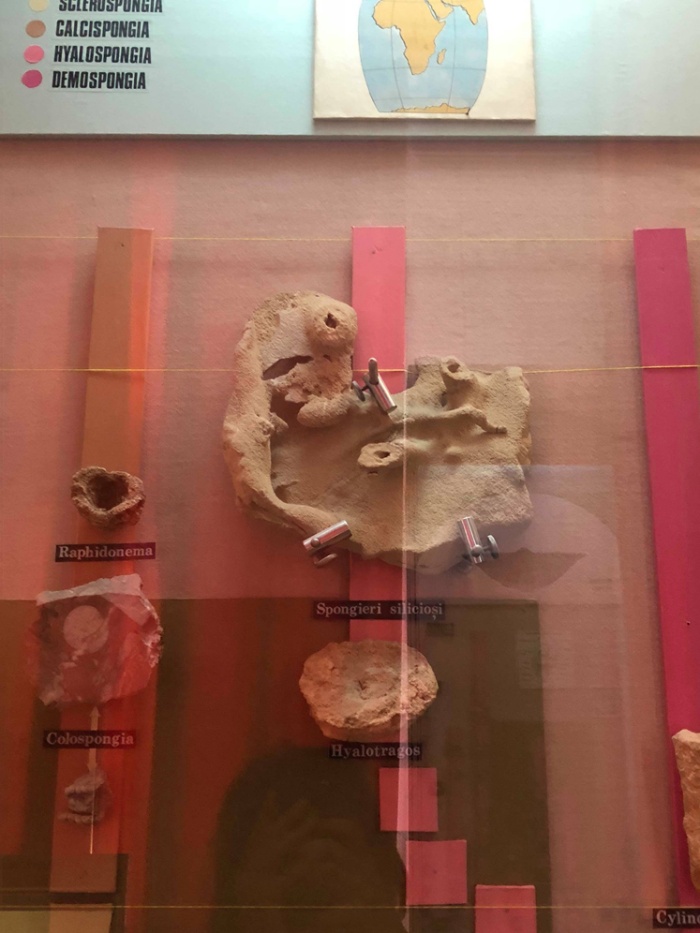
Narodowe Muzeum Geologiczne w Bukareszcie. Zdjęcie: Bianka Basan. Dzięki uprzejmości artystki.
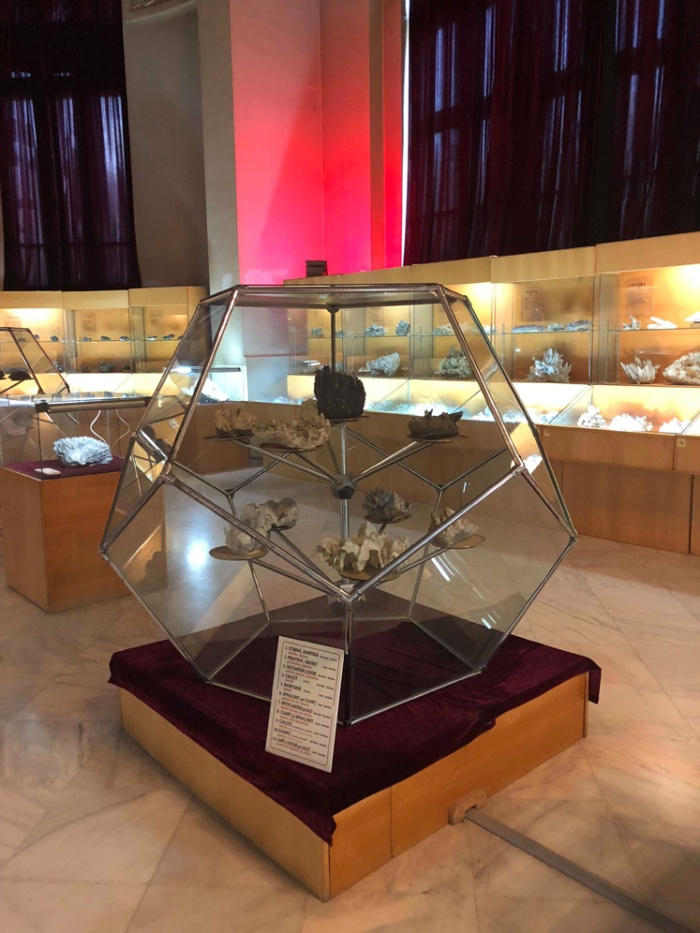
Narodowe Muzeum Geologiczne w Bukareszcie. Zdjęcie: Bianka Basan. Dzięki uprzejmości artystki.
Anthropogenic Planet: Life and Immortality
Plastic – the most prominent of all the anthropogenic substances – not only penetrates the bodies of organisms – by the same token co-creating them in their process of becoming-Earthlings, but it also combines with the geological layer of the planet in the process of becoming-the-Earth. The latter is most acutely apparent in plastiglomerate, that is, a rock neo-creation that combines plastic, volcanic rock, coral skeletons, and shells.[5] Plastiglomerate – the name proposed by the geologist Patricia Corcoran, oceanographer Charles J. Moore, and artist Kelly Jazvac, was first found and came to attention[6] on Kamilo Beach on the Big Island of Hawaii. The beach is well-known for its huge agglomeration of rubbish brought here by currents and the swell. At first it was thought that humans had nothing to do with the actual process of how the conglomerate comes into being; it was considered that it was created as a result of various components being inundated with hot lava. Today we know, however, that it is not volcanoes but people that create plastiglomerate – by burning plastic waste on polluted beaches or lighting fires that involve plastic. Plastiglomerate is thus not a local creation, limited to volcanically active areas, but can be found in many places around the world.
Processually and materially bound with human activity, it has become one of the most characteristic materials in the present era of the Anthropocene. Plastiglomerate is predicted to survive even longer than plastic itself as the fossil of the future, especially if it is not exposed to sunlight, submerged deep in the ocean or buried in the ground. The materiality of the plastic itself must be seen in planetary terms not only spatially, due to the prevalence of the material, but also temporally, due to the perspective of its geological duration, i.e. deep time. For, produced from crude oil, plastic reaches into the deep past of the Earth to the bodies of long extinct humans, and thanks to the vitality and indestructibility of its micro-particles it looks into their deep future. Therefore, we are afraid of plastic mainly because it does not die, and, as Heather Davis emphasizes, it exerts a significant impact on the environment, while the impact of the environment on plastic is negligible. “Plastic is the ultimate material of tempophagy, or time-eating, one that consumes the compressed bodies of ancient plants and animals, a process that took thousands of years, only to be transformed into a single-use take-out container.”[7] Short life and a long dying, or rather a long life after life, results from the use of plastic in the manufacture of packaging and other disposable items. Today it is becoming more and more obvious that we can only resolve the plastic problem created by our species in conjunction with other life-forms such as bacteria, protozoa, fungi, algae, and insects – capable of carrying out biodegradation, i.e. the biochemical decomposition of organic compounds into simple compounds. The power of these organisms grows in step with the rise of plastic mountains and the territorial expansion of the Waste Islands.
The Earth without Earthlings? Earthlings without the Earth?

In the face of the relentless devastation of the planet, Donna Haraway postulates “staying with the trouble,”[8] which is after all human-generated. Such a stance provides an alternative to, on the one hand, techno-enthusiasm and, on the other, catastrophism. Both attitudes are dangerous, because they essentially promote ignoring the mounting ecological problems and dismiss the option of each human undertaking, here and now, aware and effective action on behalf of the planet. Techno-enthusiasts suggest that it is only in the future that we will find solutions to the problems that we are experiencing, this means, in a nutshell, that we might just as well simply sit back and wait for a cure-all solution. One such option is supposed to be relocation to other planets, leaving Planet Earth in emergency mode, due to the irreversible destruction wreaked on non-human Earth dwellers. In this scenario, selected Earth species, whether taken on board a spacecraft by humans or as stowaways, would continue their existence elsewhere in space, now without any material connection to the Earth.
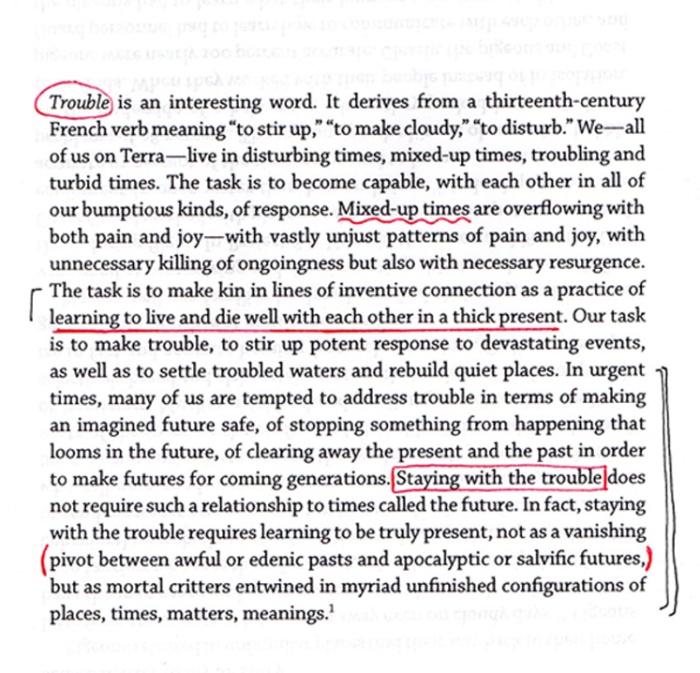
Strona ze wstępu do "Staying with the Trouble" Donny Haraway.
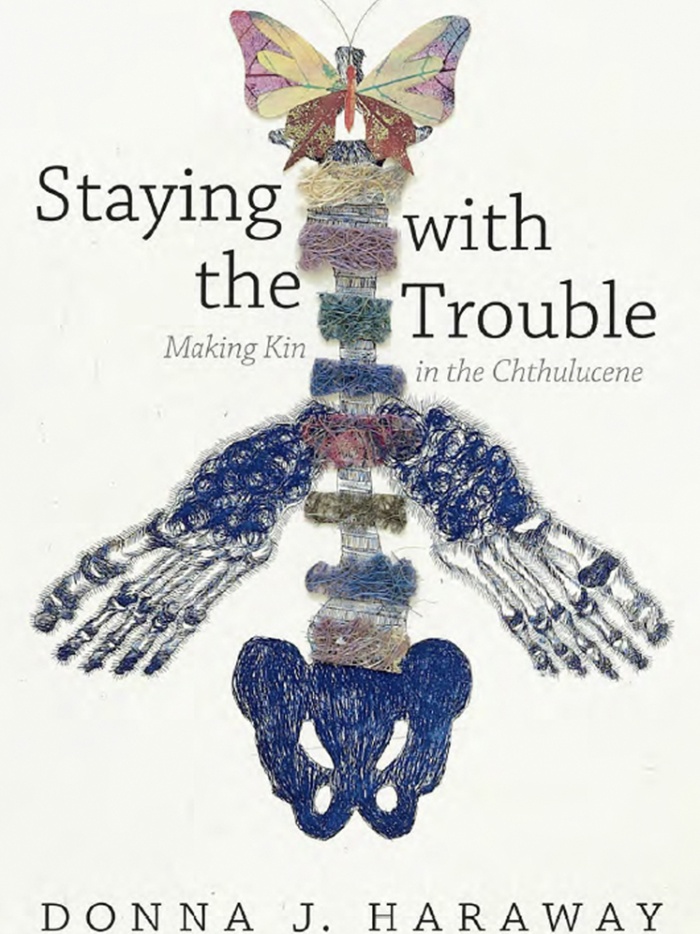
Okładka "Staying with the Trouble" Donny Haraway.
In turn, ecological catastrophism is based on the premise that it is already too late to take action. In that spirit, it postulates life-as-we-know-it, waiting for the final extinction – to which we are inevitably doomed. We humans find the ultimate annihilation of our own species horrifying yet fascinating; it could take a number of different routes, one of which is related to plastic. Through the penetration of the human body and impeding of our procreative functions, plastic itself seems to have taken the place of the ultimate, biological progeny of the humans and other species. Davis seems to be in concord, asking what kind of progeny plastic is. One of the possible answers is that, through the elimination of biological human offspring, plastic, paradoxically, offers, in fact, a chance to save the planet from ourselves. The growing human population escalates the amount of plastic generated – in the process devastating the environment and making it impossible for other species to survive. With it, plastic brings a new, different power system – a new network of metabolic links and territorial impacts, one that is to a large extent created beyond our sphere of influence, in which we are not the main actors.
Indifference to the wrongs and devastation that stem from techno-enthusiasm and catastrophism are synonymous with opting for instant gratification in terms of convenience. Indeed, it is an expression of our human speciesism. However, as Haraway urges, the most pressing imperative right now is to develop an appropriate approach to support thinking and action underpinned by inter-species goals. Staying with the trouble that threatens both human and non-human Earthlings provides an opportunity to properly identify it so that every one of us and on all levels can seek solutions. For human Earthlings, our identification with all Earth-dwelling species as well as the Earth itself is the sine que non for a better understanding of the planetary problems, or, effectively – our own “trouble.”
Translated from Polish by Anda MacBride
BIO
Monika Bakke is Associate Professor in the Philosophy Department at the Adam Mickiewicz University, Poznań, Poland. She writes on contemporary art and aesthetics with a particular interest in posthumanist, transspecies, and gender perspectives. She is the author of Bio-transfigurations: Art and Aesthetics of Posthumanism (2010) and Open Body (2000) co-author of Pleroma: Art in Search of Fullness (1998), and editor of Australian Aboriginal Aesthetics (2004), as well as Going Aerial: Air, Art, Architecture (2006) and The Life of Air: Dwelling, Communicating, Manipulating (2011). From 2001 until 2017, she was editor of the Polish magazine Czas Kultury.
*Cover photo: Nicoleta Moise. Courtesy of the artist. See: https://en.wikipedia.org/wiki/Cat's_cradle.
[1] Elizabeth Grosz, Becoming Undone. Darwinian Reflections on Life, Politics, and Art, Duke University Press, Durham 2011, p. 33.
[2] Kathryn Yusoff, Geologic Life. Prehistory, Climate, Futures in the Anthropocene, in: “Environment and Planning,” vol. 31, 2013, p. 779.
[3] See Elizabeth A. Povinelli, Geontologies: A Requiem to Late Liberalism, Duke University Press, Durham, London 2016.
[4] Ibidem, p. 19.
[5] Patricia L. Corcoran, Charles J. Moore, Kelly Jazvac, “An Anthropogenic Marker Horizon in the Future Rock Record,” The Geological Society of America Today, vol. 24 (6), June 2014. Available online: http://www.geosociety.org/gsatoday/archive/24/6/article/i1052-5173-24-6-4.htm
[6] It was first exhibited as a new geological formation in the Museum of Natural History of Yale University, see: http://peabody.yale.edu/exhibits/plasti-what-plastiglomerate [date accessed: 3 March 2019].
[7] Heather Davis, Toxic Progeny: The Plastisphere and Other Queer Futures, philoSOPHIA. A Journal of Continental Feminism, vol. 5.2, summer 2015, p. 234.
[8] Donna J. Haraway, Staying with the Trouble. Making Kin in the Chthulucene, Duke University Press, Durham, London 2016.



